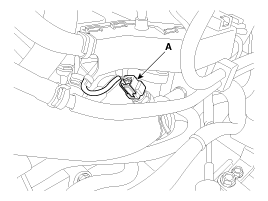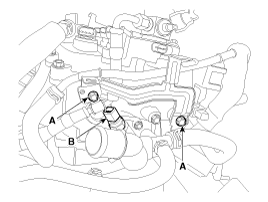Inspection
|
1. |
Turn the ignition switch OFF.
|
|
2. |
Remove the ECTS (Refer to "Removal").
|
|
3. |
After immersing the thermistor of the sensor into engine coolant,
measure resistance between the ECTS terminals 1 and 3.
|
|
4. |
Check that the resistance is within the specification.
Specification:
Refer to “Specification”
|
|
Removal
|
1. |
Turn the ignition switch OFF and disconnect the battery negative
(-) cable.
|
|
2. |
Disconnect the engine coolant temperature sensor connector (A).

|
|
3. |
Disconnect the ignition coil connector (A) and CMPS connector
(B).
|
|
4. |
Unfasten the harness bracket (C) and Make a gap for removing high
pressure fuel pipe by moving the bracket (C).

|
|
5. |
Remove the vacuum pipe mounting bolts (A).
|
|
6. |
Remove the engine coolant temperature sensor (B).

|
|
7. |
Fill with engine coolant.
(Refer to Engine Mechanical System -"Coolant")
|
Installation
| •
|
Install the component with the specified torques.
|
| •
|
Note that internal damage may occur when the component
is dropped. If the component has been dropped, inspect before
installing.
|
|
| •
|
Apply the engine coolant to the O-ring.
|
|
| •
|
Insert the sensor in the installation hole and be careful
not to damage.
|
|
|
1. |
Install in the reverse order of removal.
Engine Coolant Temperature Sensor
mounting :
29.4 ~ 39.2 N.m (3.0 ~ 4.0 kgf.m, 21.7 ~ 28.9 lb-ft)
|
|
Circuit Diagram
(M/T)
(A/T)
...
Description
Crankshaft Position Sensor (CKPS) detects the crankshaft position and
is one of the most important sensors of the engine control system. If there
is no CKPS signal input, the eng ...
See also:
Scheduled maintenance service
Follow the Normal Maintenance Schedule if the vehicle is usually operated where none of the following conditions apply. If any of the following conditions apply, follow the Maintenance Under Severe ...
Components and Components Location
Components Location
1. Engine Control Module (ECM)
2. Manifold Absolute Pressure Sensor (MAPS)
3. Intake Air Temperature Sensor (IATS)
4. Engine Coolant Temperature Sensor (ECTS)
...
Panorama Sunroof Assembly Installation
•
In order to mount the panorama sunroof assembly, use the
tools shown in the followin ...
 Kia Soul: Engine Coolant Temperature Sensor (ECTS). Repair procedures
Kia Soul: Engine Coolant Temperature Sensor (ECTS). Repair procedures Engine Coolant Temperature Sensor (ECTS). Schematic Diagrams
Engine Coolant Temperature Sensor (ECTS). Schematic Diagrams Crankshaft Position Sensor (CKPS). Description and Operation
Crankshaft Position Sensor (CKPS). Description and Operation



